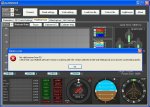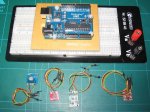Hiho
Keine Widerstände nur die Freeimu anschliessen ,die Imu hat alles drauf, 5 volt -minus -scl-sda.
/* This option should be uncommented if ACC Z is accurate enough when motors are running*/
/* should now be ok with BMA020 and BMA180 ACC */
#define TRUSTED_ACCZ
Das kannste Rausnehmen ,hast ja jetzt Imu
#define I2C_SPEED 100000L //100kHz normal mode, this value must be used for a genuine WMP
//#define I2C_SPEED 400000L //400kHz fast mode, it works only with some WMP clones
Auf 400hz setzen
Das kann man nehmen ,muss man aber nicht . Ich hab ihn auf 6-8 gesetzt.
/* introduce a deadband around the stick center
Must be greater than zero, comment if you dont want a deadband on roll, pitch and yaw */
//#define DEADBAND 6
Den Filter kann man setzen muss man aber nicht,ich hab ihn auf 42 hz. bei 3.7 auf Roll und Pitch.
Ohne Filter muss ich so ca. 8-9 Roll und Pitch stellen.
/* MPU6050 Low pass filter setting. In case you cannot eliminate all vibrations to the Gyro, you can try
to decrease the LPF frequency, only one step per try. As soon as twitching gone, stick with that setting.
It will not help on feedback wobbles, so change only when copter is randomly twiching and all dampening and
balancing options ran out. Uncomment only one option!
IMPORTANT! Change low pass filter setting changes PID behaviour, so retune your PID's after changing LPF.*/
//#define MPU6050_LPF_256HZ // This is the default setting, no need to uncomment, just for reference
//#define MPU6050_LPF_188HZ
//#define MPU6050_LPF_98HZ
//#define MPU6050_LPF_42HZ
//#define MPU6050_LPF_20HZ
//#define MPU6050_LPF_10HZ // Use this only in extreme cases, rather change motors and/or props
Hier noch von Alex aus dem Multiwii Forum:
http://www.multiwii.com/faq#Starting_running_amp_stopping_MultiWii
Starting, running & stopping MultiWii
The motors do not start
Move the rudder full right with throttle all the way down to start the motors, full left to turn off the motors.
If the LED stays off, it is a problem related to the RX setup.
If the LED is going ON after the arming procedure, it is a problem related to the ESCs.
The motors still do not start or start but do not stop any more
You have to adjust the travel of your channels so it has a range from 1000 to 2000 on the GUI.
Most likely you need to extend your channel endpoints on your transmitter so the minimum & maximum request is changing from 1000 to 2000.
For Graupner/JR radio, it implies an ATV of 125% for all channels.
On most radios, the endpoints or travel adjusts must be increased to approximately 120% till140%. to get a 1000 to 2000 range in the GUI.
If this range is not matched, the arming level value can’t be reached on the yaw channel, and it’s not possible to arm the motors.
Before trying to operate the MultiWii copter, it’s important to set the end points with the help of the GUI.
The motors still do not start, what about the minimum throttle signal send to the ESC’s
In some cases the ESC’s do not start with the supplied standard minimum throttle value.
It’s possible to lower this value in order to start the ESC’s.
One can try to lower the MINCOMMAND value with steps of 50 to 950 or 900.
The motors start & stop but after trimming the yaw it’s no longer possible to start or stop the motors
By setting the trim, the complete range moves up or down so the endpoint does not reach the desired 1000 or 2000 any more.
One transmitter suffering from this is e.g. the very basic Planet T5 2.4Ghz transmitter.
Be sure your ESC can support PPM with 490Hz refresh rate
For the MultiWii we need a fast update rate & ESC’s which can handle that.
There are a number of standard ESCs than can handle update rates of about 490 Hz, namely Turnigy Plush, Mystery Blue, HK SS and a few others.
The 490Hz basically means that the ESC gets 490 times per second an update.
A standard servo for example works at 50hz or is updated 50 times per second.
Here is a diagram with the different frequencies used in the MultiWii project
Why is it important to define the minimum running value for the ESCs ?
The motors should always run whatever the situation in flight:
•ESCs and motors are not perfect and does not synchronize every time at the beginning. If this happens in the air, one motor won’t be able to spin and I let you imagine the situation.
•Gyro-induced corrections can put a ESC in a situation where it is under its running limit (motor stop). It should not be important because it lasts a fraction of second and propellers have some inertia. But I observed a very annoying behavior with Turnigy Plush ESCs: once it is below the running limit, the ESC reaction time to return into the running range is very high, causing crashing oscillations.
If you choose another ESC, you have to tweak this “minimum spinning value”.
The value depends also of the way the ESCs ware calibrated.
Once armed, if the motors are not running, this value must be changed.
This parameter is very important and has to be edited to compile arduino code.
It is one of the key to have a stable multicopter in descent.
One motor stops suddenly in a flight
It may occur if your ESC is configured in soft mode.
It is preferable to set the ESCs in MEDIUM or HIGH mode.
A simple test to check this problem:
- hold the multicopter firmly in your hand
- start the motors and put a little throttle (enough to feel the gyro correction)
- shake it to counter the motor reaction
- if one motor stops, the problem is then related to motor-ESC combination and you probably need to adjust the timing
Und wech




